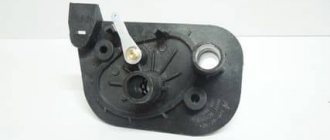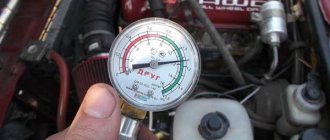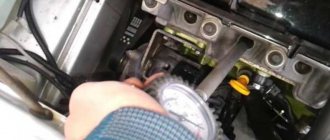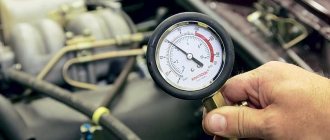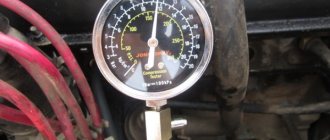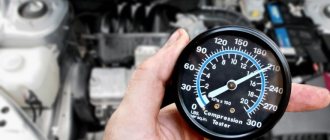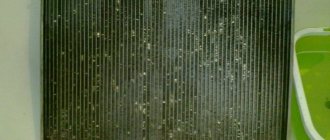For most experienced car enthusiasts, it is well known that the ease of starting the internal combustion engine, as well as the stability of the further operation of the power unit, directly depends on the compression ratio in a gasoline or diesel internal combustion engine. Compression also greatly affects power, fuel and engine oil consumption, as well as the life of the power plant.
As a rule, many drivers and auto mechanics, during superficial diagnostics, identify a number of breakdowns and determine the general condition of the engine precisely by the compression indicator. At the same time, measuring compression in the engine is not difficult. This operation is easy to implement in a regular garage; the engine does not need to be disassembled, and no special tools or equipment are required.
It is enough to unscrew the spark plugs on a gasoline engine or the glow plugs on a diesel engine, after which a compression gauge is installed through an adapter into the spark plug wells. Then the engine is cranked from the starter, measuring the compression readings in each cylinder and comparing them with the norm for a particular type of internal combustion engine.
However, although measurements are relatively easy to take, accurately determining the cause of deviations from the norm is much more difficult, since compression can be low or high for a variety of reasons. Next we will talk about why increased compression occurs in the engine, and why it can also decrease.
Compression End Pressure
Compression is a popular expression, the correct term is “compression end pressure.”
It is created in the cylinder by the movement of the piston when the ignition is turned off and without fuel supply. To measure the pressure in the cylinders, technicians in technical services usually use a special device - a compression meter, which is screwed in instead of a spark plug. The measuring element is inside the cylinder. Next, the crankshaft is spun by the starter, and the arrow shows a certain value on the scale.
The higher the compression, the more power the power unit can develop. It depends on the condition of the piston rings and their degree of wear. The valve plates gradually burn out, do not fit tightly into the seat and allow gases to pass through. A “stuck” valve or a burnt-out piston does not allow the required pressure to be created in the cylinder.
If they are damaged, gases penetrate into the crankcase, the engine cannot develop its designed power, and its characteristics are distorted. If in one cylinder the compression is 25% lower than in the others, then engine repair with complete disassembly is necessary.
Normal compression values for common 1.6-liter naturally aspirated engines are considered to be 11-12 bar. In old VAZ carburetor engines, the minimum threshold is 10 bar. A new unit in excellent condition should show 13 bar just off the assembly line.
It is impossible to increase compression indefinitely due to the risk of detonation. The air-fuel mixture heats up during compression and can ignite randomly even before the compression cycle is completed. That is, the mixture will explode ahead of time, causing damage to engine parts.
Checking with a compression gauge
To measure the pressure in the engine cylinders, it is necessary to use a special tool - a compression gauge. The cost of such a device is low, so any car owner can purchase it. In addition to it, you will need a spark plug wrench and an assistant - he will have the important task of rotating the starter using the ignition key.
- The machine warms up to operating temperature.
- Carefully unscrew all spark plugs.
- The throttle valve opens, that is, the assistant presses the accelerator pedal all the way, while simultaneously turning the ignition key and thereby setting the starter in motion.
- The compression tester plug is tightly inserted into the spark plug well. The starter starts and the engine “cranks” for two to three seconds - this time is enough for the pressure gauge readings to stop increasing.
- The starter stops and the measurement data is recorded. Compression is measured in all engine cylinders.
- The compression gauge is completely emptied of air before each subsequent measurement. If the results obtained deviate from the norm, the readings are taken again.
Measuring engine compression using a compression meter video:
Compression values measured in different cylinders should be about 10% of the maximum pressure value indicated on the instrument scale. A decrease in results below 15% of the maximum indicates wear of parts - piston, valves, piston rings or cylinder. Operating a car engine in this condition risks its complete failure, major repairs, or complete replacement in the future.
The main difference between the process of measuring compression on an injector and a carburetor is the mandatory disconnection or removal of the crankshaft sensor. Experts advise doing this in order to protect the ECU from damage and completely shut off the fuel supply.
What factors influence compression?
The fuel cylinder is a working chamber of volumetric displacement. It is a closed-type system consisting of a large number of parts:
- valves;
- cylinder head;
- piston and rings;
- cylinder walls.
Each element affects the performance of the system. If one of them is damaged or severely worn, the pressure decreases. A cracked piston will lead to exhaust gas leakage. This will have a bad effect on power characteristics.
The pressure level often decreases due to damaged or dirty rings. Incorrectly set valve timing, low-quality composition of the working mixture, and an incorrect injection timing angle also cause the formation of carbon deposits in the valves. This ultimately leads to loss of pressure and further problems.
What affects the compression level
The degree of compression depends largely on the state of the following nodes:
- cylinder block;
- head (with a set of intake and exhaust valves);
- pistons (with a set of compression and oil rings);
- connecting rods;
- crankshaft.
Together they form a cylinder-piston group. It is she who makes a significant contribution to the operation of the engine.
Details about the purpose of a car catalyst are presented in this article.
How to remove scratches on plastic in a car and which of them you can deal with yourself - find out in our material.
Standards and norms
There is an opinion among owners of modern cars that the compression of a hot engine can be from 8 to 10 atm.
The compression rate in the cylinders of any engine is from 12 atm, with rare exceptions.
Cars use engines of various configurations, determined by the number of valves and camshafts, the geometry of the intake manifold, and the installed connecting rod and piston group. In accordance with this, its specific compression ratio is calculated - this is the ratio of the total volume of the cylinder to the volume of the combustion chamber.
The higher the compression ratio, the higher the compression value. For gasoline engines, the compression ratio is in the range of 8 - 12 units, which is indicated in the technical documentation of a particular car. Theoretically, it is not difficult to determine what the compression in the cylinders should be for a particular engine. It is enough to multiply the compression ratio by a factor of 1.3.
For example, the compression ratio in the car’s characteristics is indicated as 9.5 units, multiplying 9.5 by a factor of 1.3 to obtain a calculated value of 12.35 atm.
What's the result?
As you can see, a high compression ratio in a gasoline engine or diesel device is no less a problem than a low compression ratio. In addition, in this case, the engine consumption also increases significantly, since increased pressure occurs in the cylinders. In this situation, important parts and assemblies begin to feel significant stress.
The most important thing to understand is that high or low compression is not a cause of failure, but a consequence of existing problems. To save engine resources and reduce its consumption, it is necessary to carry out comprehensive diagnostics and repairs and thus quickly bring the compression indicator to the calculated standard.
In conclusion, if the compression value has changed, you should find the reason as soon as possible to prevent more serious consequences, especially for high compression. High compression ratio can damage the cylinder head, empty valves, etc. Which significantly increases the overall costs of subsequent engine repairs.
Compression testers
A compression gauge is a device consisting of a pressure gauge with a scale, a pressure relief valve and tips. The most convenient is a flexible hose with a threaded end, in which a nipple is installed to prevent air from escaping back out of the device. Checking compression in engine cylinders that include spark plug wells in their design is carried out by screwing a flexible hose into the threaded hole of the spark plug, which eliminates the loss of compressed air from loose fitting of rigid tips without threads.
Signs of malfunctions with reduced compression when hot in different modes
If the compression is below the nominal value when the throttle valve is open, this indicates an air leak. It can go away when severe wear on the compression rings , significant scuffing on the bore of one or more cylinders, abrasion on the piston/pistons, a crack in the cylinder block or on the pistons, burnout or “hanging” in one position of one or more valves.
After taking measurements at a wide open throttle, you should check the compression with the throttle valve closed. In this mode, a minimum amount of air will enter the cylinders, so you can “calculate” the minimum air leaks. Typically, in this way it is possible to determine the deformation of the valve stem/valves, wear of the valve seat/valves , and burnout of the cylinder head gasket.
For most diesel engines, throttle position is not as critical as for gasoline power units. Therefore, they simply measure compression in two engine states - cold and hot. Usually with the throttle valve closed (gas pedal released). The exception is those diesel engines that are designed with a valve in the intake manifold designed to create a vacuum used to operate the vacuum brake booster and vacuum regulator.
It is advisable to carry out a hot compression check not just once , but several times, while recording the readings in each cylinder and at each measurement. This will also allow you to find faults. For example, if during the first test the compression value is low (about 3...4 atmospheres), and later it increases (for example, up to 6...8 atmospheres), then this means that there is wear on the piston rings, wear on the piston grooves, or scuffing has appeared on the cylinder walls . If, during subsequent measurements, the compression value does not increase, but remains constant (and in some cases may decrease), this means that air is leaking somewhere through damaged parts or their loose fit (depressurization). Most often these are valves and/or their seats.
Compression test when hot with oil added
The process of measuring compression in engine cylinders
When measuring, you can increase the compression by dropping a little (about 5 ml) of engine oil inside the cylinder. In this case, it is important that the oil does not get to the bottom of the cylinder, but spreads along its walls. In this case, the compression in the cylinder under test should increase. If the compression is low in two adjacent cylinders, and adding oil did not help, the cylinder head gasket is most likely broken . Another option is a loose fit of the valves to their seats, burnout of the valves, incomplete closure as a result of improper adjustment of the clearances , burnout of the piston or a crack in it.
If, after adding oil to the cylinder walls, the compression increased sharply and even exceeded the values recommended by the factory, this means that there is coking or stuck piston rings .
Additionally, you can check the cylinder with air. This will make it possible to check the tightness of the cylinder head gasket, piston burnout, and cracks in the piston. At the beginning of the procedure, it is necessary to install the diagnosed piston at TDC. Next, you need to take an air compressor and apply air pressure equal to 2…3 atmospheres to the cylinder.
If the head gasket is blown, you will hear the sound of air escaping from the adjacent spark plug well. If on carburetor machines the air in this case comes out through the carburetor, this means that there is no normal fit of the intake valve. You also need to remove the cap from the oil filler neck. If air comes out of the neck, then there is a high probability of a crack or burnout of the piston. If air comes out of the exhaust tract elements, this means that the exhaust valve/valve is not tightly attached to the seat.
In addition, it is useful to keep records and compare compression as the engine wears. For example, every 50 thousand kilometers - at 50, 100, 150, 200 thousand kilometers. As the engine wears, compression should decrease. In this case, measurements must be performed under the same (or similar) conditions - air temperature, engine temperature, crankshaft rotation speed.
It often happens that for engines whose mileage is about 150...200 thousand kilometers, the compression value is the same as that of a new car. In this case, you should not be happy at all, since this does not mean that the engine is in good condition, but that a very large layer of soot has accumulated on the surface of the combustion chambers (cylinders). This is very harmful for the engine, as it hinders the movement of the pistons, promotes sticking of the rings and reduces the volume of the combustion chamber. Accordingly, in such cases it is necessary to use cleaning products or it is time to overhaul the engine.
Conclusion
Compression testing is usually done “hot”. Its results can indicate not only its decrease, and therefore a decrease in engine power, but also help identify faulty elements in the cylinder-piston group, such as wear on the compression rings, scuffing on the cylinder walls, a broken cylinder head gasket, burnout or “freezing.” » valves. However, for comprehensive engine diagnostics, it is advisable to perform a compression test in different engine operating modes - cold, hot, with the throttle valve closed and open.
How often to check compression
For prevention, diagnostics are carried out when replacing spark plugs. This procedure should be carried out every 25-50 thousand km.
In addition, emergency diagnosis is carried out for the following signs:
- The engine consumes a lot of oil - more than 200 ml per 1000 km.
- Blue smoke comes out of the exhaust pipe.
- The car has become harder to start in winter.
- Unstable idle, vibration.
The last symptom indicates a failure of the ignition system or several spark plugs. Before measuring compression, these faults must be eliminated. On diesel engines, wear of valves, pistons and cylinders shows the same signs. Cold starts are especially noticeable - diesel fuel cannot ignite.
Compression measurement of gasoline and diesel engines
The list of general requirements in order to accurately measure compression includes:
- The engine must be warmed up to 80-90 degrees;
- The fuel supply must be turned off;
- All candles without exception must be unscrewed;
- The starter must be absolutely in good working order;
- The battery must be fully charged;
- In the case of a manual gearbox, you can engage the upper (over) gear and also prevent the vehicle from moving. To do this, use the parking brake and/or wheel chocks. It is also possible to measure compression in the “neutral” position of the manual transmission lever. In cars with an automatic transmission, the selector is set to parking mode (P).
- The next step is to check the condition of the air filter. Before measuring compression, a dirty filter is replaced with a new one. The second method is to temporarily disconnect the air supply line from the inlet.
- In gasoline internal combustion engines, the ignition system will need to be turned off. To do this, it is necessary to disconnect the wiring from the breaker to supply low voltage, which is supplied to the ignition coil. Motors equipped with an ignition distributor will require removal of the main high-voltage wire from the coil. The specified wire is then connected to ground.
- To effectively shut off the fuel supply in designs that include a mechanical fuel pump, the fuel line will need to be disconnected. Next, the pipe is turned off. For an electric fuel pump, it will be enough to remove the contact from its relay.
- Afterwards, the places for installing the spark plugs are cleaned of dirt and the tips of the high-voltage wires are removed from the spark plugs. Then the candles are unscrewed.
- With the spark plugs removed, you will need to turn the engine over several times with the starter. The procedure is necessary to clean the cylinders from possible carbon deposits and other deposits.
- The last step is to connect the compression gauge to the spark plug well of the cylinder. It is better to measure compression with a partner who will press the accelerator pedal all the way. The gas pedal is depressed so that the compression measurement is carried out with the throttle valve open, and due to this, the intake resistance is reduced. With the pedal depressed, the engine is turned with the starter for about 5 seconds. It is necessary to monitor when the highest value appears on the scale. The indicated value is noted and further measurements are taken in other engine cylinders.
As for the features of measuring compression on a diesel engine, then:
- Turning off the fuel supply in a diesel engine is achieved by pressing down the cut-off lever. This lever is located on the injection pump. The second way is to turn off the solenoid valve, which will also block the fuel supply to the diesel internal combustion engine. This valve is located on the fuel line, which is responsible for supplying fuel.
- The compression gauge in a diesel engine is connected through the holes of the injectors or glow plugs. This depends on which elements are more convenient to reach, as well as according to the recommendations for a particular type of diesel engine.
- To measure compression on a diesel engine, you will need a special compression meter, which will have an appropriate tip for secure fastening in the hole of the injector or glow plug. The maximum measurement threshold for such a compression meter for a diesel engine should be higher compared to its gasoline counterpart. A diesel compressometer should be able to record a pressure of about 60 atmospheres.
- When measuring diesel compression, there is no need to press the gas pedal. The fact is that most diesel engines do not have a throttle valve. Only diesel engines that have a special valve in the intake stand separately. The valve is necessary to create vacuum. The vacuum will ensure the functionality of the vacuum regulator and brake booster.
If you take measurements by unscrewing only the spark plug in one cylinder, then there is a noticeable increase in the resistance to crankshaft rotation. When the starter cranks, this resistance leads to a decrease in speed. If the battery is faulty or has a weak battery, you can use a jump starter, although this method is not recommended.
Symptoms of low engine compression
Actually, we have already talked about the signs of decreased compression in car engines. Another thing is that the car can trip and shake for other reasons, with engine compression, which have nothing to do with it. However, if the engine begins to consume oil, if its operation has become unstable, and even for no apparent reason, you should measure the compression in the cylinders of your car. Also, a decrease in compression can be caused by a drop in traction, an increase in fuel consumption and an increase in vehicle acceleration time. As for the difference in compression in different cylinders of the same engine, as long as this value does not exceed one atmosphere, there is no problem. If the difference is greater, the motor should be repaired.
High compression in the engine
So, as mentioned above, compression in the power unit can be influenced by a number of factors. Let's start with increased compression. First of all, increased compression usually indicates that there is a problem with the engine. As a rule, the main symptom is unstable engine operation, discoloration of the exhaust and increased oil consumption.
Typically, in many cases, car enthusiasts are faced with so-called “oil” compression, when general engine coking and problems with oil scraper rings lead to excess oil and carbon deposits actually reducing the volume of the combustion chamber. The result is an increase in compression.
In other words, an increase in compression is caused by carbon deposits on the timing valves, the accumulation of coke in the combustion chamber and the occurrence of oil scraper rings. A common cause is also engine overheating, when oil loses its properties due to high temperatures and quickly contaminates the combustion chamber.
Other reasons include the use of additives in the lubrication system, pouring inappropriate or low-quality oil for the engine, constant operation of the engine on low-grade fuel, etc.
One way or another, the accumulation of coke and soot leads to a decrease in the volume of the combustion chamber in which the fuel-air mixture is compressed. Naturally, in this case, when taking measurements, the compression meter will show too high a compression.
Let us also add that deviations from the norm can be caused by incorrect installation of valve timing. Simply put, errors when aligning the pulleys when replacing a timing belt or chain will lead to the drive element jumping several teeth (on an internal combustion engine with a belt) or links (on chain engines) forward or backward.
To avoid possible problems, it is necessary to pay special attention to the location of the marks on the pulleys, engine housing, etc., that is, set the timing drive, and also correctly tension the chain or belt.
Also, the cause of high compression may be a combination of problems with valve stem seals and rings. If, after unscrewing the spark plugs in the cylinders, a clear excess of oil is visible in the form of a thick oil film on the cylinder walls, then this clearly indicates the need to replace the valve seals.
If we summarize the information why increased compression occurred in the engine, the reasons are as follows:
- there is a lot of oil in the engine cylinders (rings are stuck, valve seals are worn, etc.);
- change in the volume of the combustion chamber as a result of the accumulation of deposits and soot, as well as engine overheating and deposits of burnt oil;
Let us also add that compression is affected by air temperature and the condition of the air filter. When taking measurements, it is advisable to disconnect the air filter. It is also important to understand that at many service stations, compression gauges have a large error.
In practice, this requires several repeated measurements on a hot engine, preferably with different and pre-calibrated instruments. There have been cases when at one station the driver’s compression was determined after measurements, for example, 12.5-13, and at another service the readings for all cylinders were already about 16.
To solve the problem of high compression, you can use several available methods. The first is disassembling the engine, physically cleaning the pistons and combustion chamber from carbon deposits, replacing rings, valve stem seals, etc. A cheaper and less effective solution is to decarbonize the engine. In a nutshell, an active cleaner is poured into the combustion chamber for a certain time to remove carbon deposits and coke, after which the deposits washed off the walls and surfaces then burn out while the engine is running.
Engine compression and compression ratio - what is it?
Almost all motorists are well aware of engine compression, but many confuse this concept with the compression ratio. In fact, these values indicate completely different engine parameters. Let's try to figure out what compression and engine compression ratio are, and we'll also figure out how to increase compression and why is it needed?
Compression in engine cylinders
Compression is the pressure that is created at the end of the compression stroke of the air-fuel mixture by the cylinder. The higher the engine compression, the more power it can develop. The fact is that increasing this value promotes better compression of the fuel, and therefore its ignition occurs much more efficiently, which gives a good push to return the cylinder to bottom dead center. The rotation speed of the crankshaft directly depends on the speed of movement of the cylinders, and therefore the engine power is determined.
Compression is measured in various quantities, but the most widely used are atmospheres. The main difference between compression and a value such as the compression ratio is the change in the constancy of this value. The fact is that as various engine parts wear out, the pressure in the cylinders decreases, and accordingly, the engine power decreases.
However, you should not allow too much compression. There are many known cases of cylinder bursts, spark plugs being pulled out and valves being bent. Compression must be selected in accordance with the manufacturer's instructions for the given engine model.
Reasons for low compression
- Incorrect adjustment of thermal clearances. The thermal gap is usually called the distance from the operating valve stem to the cam located on the engine camshaft. Incorrect adjustment of such a gap can disrupt the tightness of the combustion chamber at the time of the compression stroke, which leads to a loss of pressure and, accordingly, a decrease in compression.
- Scratches on the cylinder walls. Engine cylinders are bored in such a way that the compression rings fit as tightly as possible to their surface. If scratches appear on the cylinder wall, the seal of the chamber is also broken, which leads to a loss of pressure and a decrease in engine compression.
- Scratches in cylinders can appear for a variety of reasons. The first of them is the use of low-quality fuel, which contains small foreign particles that cause scratches. The second is severe contamination of the air filter or operation of the engine without it. In this case, the most common dust appears in the form of particles, which clogs the combustion chamber and engine cylinders. The final source of damage is contaminated oil, which also has a detrimental effect on the cylinder walls.
- Defective compression rings. In the language of auto mechanics, this means “the rings are stuck.” The rings, which are responsible for maintaining normal pressure in the cylinder, lost their sealing properties and began to release some of the gases and air-fuel mixture into the crankcase with oil.
- Incorrect ignition timing setting. This is perhaps the most significant reason, because not only the pressure in the cylinders can decrease, but also the starting properties of the engine. After all, incorrectly opening the valves and supplying the fuel mixture at the wrong stroke of the engine also leads to a decrease in pressure in the cylinders.
Video - How to check compression in cylinders
How to increase engine compression?
To increase engine compression, you need to find the cause of the problem, and only then begin to fix the problem. Today, there are many ways to solve certain problems associated with poor sealing of the combustion chamber. Let's start with the piston group of the engine.
If earlier, for the concept of compression, mandatory engine repairs were done, and in particular, its boring and replacement of pistons, but now this method is gradually becoming a thing of the past. Currently, there are a large number of various additives that can eliminate defects without surgical intervention. They replenish lost parts of the metal and increase the viscosity of the oil in the damaged area. Thus, they not only eliminate the malfunction, but also raise the compression to the optimal values prescribed by the manufacturer. Despite the simplicity of this method, it is recommended to use it only if you are one hundred percent sure that the problem lies precisely in defects in the parts.
If the loss of compression is associated with coking of the piston rings, then other methods must be used. For decarbonization, special automotive chemicals are used, but there are also old methods that are successfully used to this day. One such method is the use of acetone and kerosene.
To begin with, be prepared for the fact that the car will have to sit motionless for about two days, preferably in a ventilated garage to avoid acetone poisoning. Remove the spark plugs and pour 50 milliliters of acetone and kerosene mixed in a 1:1 ratio into the holes. Next, lift one of the drive wheels, engage fourth gear and turn the wheel a few revolutions. Take short breaks between turns to allow the mixture to thoroughly work on the surfaces. Do not under any circumstances wrap the spark plugs!
Now leave the car for 18 hours and after this time, get ready to start the engine. First, you need to crank the starter without spark plugs to throw out any remaining mixture. Next, the oil is completely drained from the engine and the pan is unscrewed. Thoroughly clean it of accumulated dirt and reinstall it with a new gasket. After this, pour flushing fluid into the engine crankcase and install the spark plugs in place. Start the engine and let it idle for about 5 minutes. It is quite possible that the exhaust will not be of the standard color, but you should not be afraid of this, since the engine is naturally cleaned. After flushing the engine, all that remains is to drain the flushing agent, change the oil and air filters, and fill in new oil. Now the compression must be restored.
What is engine compression ratio?
If compression shows the pressure created in the engine cylinders, then the compression ratio is the most common ratio of the working volume of the entire cylinder to the volume of its combustion chamber. This value does not have a unit of measurement, since it only shows a ratio, and is a constant (that is, unchanging) value for your engine model. Like compression, compression ratio also affects engine power.
Knowing the compression ratio of the engine, you can easily determine the normalized compression for your engine model. To do this, it is necessary to multiply the compression ratio by 1.4 atmospheres. Naturally, the value will be only approximate, but it will be enough to compare with experimentally obtained values.
How to find the compression ratio? To do this, you need to know the engine displacement in cubic centimeters. Divide this value by the number of cylinders in your engine and then you will get the displacement of one cylinder.
To determine the volume of the combustion chamber, set the piston to top dead center and fill the space with oil squeezed out of the syringe. The amount of oil squeezed out will correspond to the volume of the combustion chamber. This way you can determine a number that shows the compression ratio of your engine.
Summarize. Based on the above, we can conclude that compression and compression ratio are different quantities. Knowing these basic principles, you can easily diagnose problems associated with the piston group of the car.
Reasons for low compression
As mentioned above, a decrease in compression occurs for several reasons, these are:
- engine service life;
- violation of maintenance (delayed oil change);
- use of low-quality oil;
- engine overheating;
- Driving with a cold engine (thermostat malfunction).
There are also reasons when additives will not help and repairs are needed, these are:
- piston burnout;
- valve burnout;
- burnout of the gasket between the cylinders;
- rings are stuck (sometimes “cured”).
Burnt out piston
Faults such as burnout are almost immediately noticeable, but some can only be determined after diagnosis.
Permissible compression difference in cylinders
If the measured compression differs between cylinders, this complicates matters. The engine will have to be disassembled and overhauled. Not only will it be necessary to replace rings, valves and sealing caps.
Compression less than the minimum value in one cylinder means that there are defects in the piston or cylinder. In this case, all elements of the cylinder-piston group are usually changed, otherwise the difference in compression will remain and the problem will not go away.
The normal value is considered to be a pressure of 10-12 bar, depending on the car model and engine. But the permissible difference in compression in different cylinders has also been established. For example, in cylinders 2 and 3 this value may be 0.5 bar lower, which is quite acceptable. It depends on the load on the pistons - where there is more, there is more wear.
Advice! If the pressure in different cylinders differs greatly, for example, by 3 or 4 atmospheres, then this is abnormal. The motor will run intermittently. This can happen in several cylinders at once, which brings a major overhaul closer.
Motor repair or replacement with a contract one?
In general, any malfunctions that lead to a decrease in compression in the engine cylinders can be eliminated. If the problem lies in the valves/cylinder head, then repair and restoration will cost 300-600 rubles. A liner for one cylinder will cost 80-120 rubles. If the pistons are damaged, they must be replaced. The price of the issue varies greatly depending on the engine and piston manufacturer. For example, for TFSI engines that suffer from oil burns, a Kolbenschmidt piston costs about 200 rubles, and the original costs 650 rubles apiece (these pistons come complete with all rings).
To these amounts should be added the costs of removing and installing the motor, disassembling and reassembling it. As a result, it turns out that the overhaul of the 2-liter TFSI/TSI engine, which is popular in terms of CPG problems, will cost about 3,600 rubles. This is if you change all four pistons. A contract engine costs from 2,500 to 3,000 rubles (plus replacement work, as well as consumables - 1,000 rubles). In this case – and we are talking about TFSI/TSI engines – many people go for a major overhaul, during which they install modernized pistons, with which the problem of “oil leakage” disappears.
Also, owners of cars whose engines chronically suffer from CPG wear: the appearance of scuffing on the cylinder walls also undergo major repairs with the block liner. This applies to many gasoline engines from BMW, Mercedes (and the Audi/VW engines mentioned above), as well as the widespread G4KD/4B11 engine (Kia, Hyundai, Mitsubishi), which is practically not offered in disassembly shops. Here it is advisable to solve the problem once and for all.
If the compression problem is associated with cylinder head wear, then you can also safely consider the option of restoring it. The work will cost, as we mentioned, 300-600 rubles, plus about 200-400 rubles for its removal and installation with replacement of the gasket.
In a large number of other cases, if a decrease in compression was caused by an accident, maintenance errors or huge mileage, you can safely consider the option of replacing the engine with a contract one. Motors that are not in great demand will cost 1000–2000 rubles, plus about 600–1000 rubles for removal and installation with oil change and necessary consumables.
Hi all! The situation is this: about 2 weeks ago, standing in a traffic jam on the way to work and looking at the car in front, I noticed that the low beam was flickering slightly. Then I didn’t attach much importance to it, I just decided to observe. A couple of days later, when I arrived home and parked, I turned on the interior lamp to illuminate the frame of the radio. which I was going to remove in order to later dismantle the radio and extend the AUX to the plug next to the cigarette lighter. So, when I turned on the lamp, I discovered that the light was not even, but flickering. I got out of the car, looked at the front dimensions - it was the same story. Then I discovered another interesting point. If on a warm car in neutral you spin the engine at 1100-1150 rpm, you will feel vibration on the steering wheel, seat... and in general on the body. And if you briefly raise the speed in neutral on a cold car, it continues to shake at idle. At the same time, when the car warms up after parking overnight, for example, the following sounds are heard from the exhaust pipe:
But I tried to remove the flickering of the light, but the vibration in the cabin is more visible when it’s cold:
As a result, I made an appointment with the OD and arrived. They held an interactive reception. They confirmed that this is not my invention and, indeed, there is a place for unstable engine operation. It was decided to measure the compression. After 20 minutes everything was ready:
1 — 13.4 2 — 15.0 3 — 14.2 4 — 14.9
Those. The compression is clearly increased. I already measured the compression a little less than a year ago and then these figures were about 3 less for each cylinder. The verdict was reached - the crankcase ventilation valve
, namely, a torn membrane. Well, there’s nothing to do, it’s undesirable to drive like that, and I agreed to replace it - fortunately I have discounts there and the price for the part will not differ from the price at the same existential, for example. I ordered and paid for everything on Friday, and a replacement arrived on Monday morning. An hour and a half later, after I dropped off the car, they called me back with the news that everything was ready, come over. I picked up the car at lunchtime. And the first thing I noticed was that the vibration when picking up speed in neutral was and remains. The mechanic responded to my complaint: I wasn’t the one who carried out the diagnostics, that technician will come out on Wednesday, if you want, leave the car. And in general, the oil just has to burn out from the cylinders... In short, I decided to pick up the car and think about what to do next. The phrase “not much should burn out of the cylinders” somehow did not convince me and even outraged me. How much oil should there be?) If it is there, it will burn out in 5 minutes of driving, but they told me to drive 500 km... So in the end I sit and think what to do and what could be the reasons for all this disgrace. Since excessive compression has been detected, options with crankcase protection supporting the engine, a dangling exhaust system, and an engine mount that has failed should seem to disappear. Next, you can consider gasoline and oil. I just changed the oil from Castrol 5w30 to the original SPECIAL PLUS 5W-40 and have already driven 8 thousand on it. I also started refueling at a BP gas station closer to home (previously I refueled at a gas station on the way out of Moscow), i.e. A purely theoretical reason can be found here.
Here are the questions running through my head right now: But what other options could there be and how to diagnose them?
Is it possible to drive with increased compression and what consequences does this have for the engine? Has anyone encountered this problem on a Polo Sedan?
The engine pulls confidently, there seems to be no jerking during acceleration. Fuel consumption is as usual (I do not observe an increase in consumption).
Poor engine compression. What can it lead to?
Low engine compression levels are always a reason to be wary, because this can cause serious problems in the operation of the engine. One of the common manifestations of low air pressure in the engine is a reduced amount of oil in the engine. This is followed by difficulties when starting the engine, increased fuel consumption, and the engine may begin to stall. What is the reason for low compression? Now I'll try to tell you.
Engine overheating
The first reason is overheating of the power unit. If the temperature reaches a critical maximum, then irreversible processes occur inside the engine. If the cylinders overheat, the pistons and rings may burn out. It happens that the piston completely burns out, compression drops and the engine fails.
Problems in the gas distribution system
The gas distribution system is responsible for the intake and exhaust of engine exhaust gases. If the valve adjustment is incorrect, this may be one of the reasons for low compression. It is also worth paying attention to the timing marks, which may not be lined correctly.
Worn piston rings
When using a car, natural wear and tear occurs. Any part wears out, the only question is when it wears out. It’s more difficult with rings, because they are not visible. If they are too worn, this will affect engine compression. However, do not forget that correct operation of the car, according to the manufacturer’s recommendations, is the key to long-term operation of the engine.
Possible reasons
- Uneven compression in the cylinders. Due to a decrease in compression, efficient combustion of the air-fuel mixture does not occur, as a result of which the piston in the problem cylinder does not receive proper acceleration. The reason for vibration at idle speed in this case is a decrease in the inertial movement of the piston during the power stroke.
- Misfire in 1 or several cylinders at once. As in the case of loss of compression, due to poor combustion of the fuel injection pump, the piston does not receive proper acceleration, which leads to uneven rotation of the crankshaft.
- Dual-mass flywheel malfunction. When in good condition, the torsional vibration damper can reduce the load on the crankshaft and transmission elements. In case of failure, engine vibrations are observed, accompanied by a characteristic rumble.
- Wear of engine mounts. The engine in the engine compartment is supported by several silent blocks. In case of cracks or tears in the rubber dampers, vibrations will be transmitted to the body and clearly felt in the cabin.
- Wear of the drive of the balance shafts and the balancers themselves. Bearing wear, chain stretching, and incorrect tensioner adjustment lead to increased noise and vibration.
Engine support cushions
How to measure engine compression ratio
How to determine that the cause of the imbalance is in the pillows?
- Visually inspect the engine mounting silent blocks. The rubber damper should not peel off from metal elements or have deep cracks.
- Using a rolling jack and a small rubber spacer, jack up the engine one at a time on all sides of the mounting of the cushions (the fulcrum should be as close as possible to the location of the damper). After each change in the position of the fulcrum, observe the operation of the motor. The vibration should noticeably decrease when the engine is jacked up near the torn mount.
Compression
Vibration associated with loss of compression will first manifest itself when it is cold. As the metal parts warm up, they expand, thereby reducing the gaps through which exhaust gases escape. Uneven compression in the cylinders is a natural phenomenon for an engine with a mileage of more than 100 thousand/km. But for normal operation, the spread should not exceed 0.5-1 kgf/cm2. At higher values, vibrations may already be observed when cold.
Compression should be checked on a cold engine. You can find out what compression should be in the engine from the repair and operation manual for your car. Following the check, you can determine what exactly caused the loss of compression: a problem with the CPG or timing parts. To do this, pour 25-30 mg of engine oil into the problem cylinder, then repeat the measurements. If the compression levels out, the reason is the wear of the CPG. The absence of changes indicates problems with the timing belt. A more accurate diagnosis of the cause of vibrations at idle can be done with a pneumatic tester.
Misfires
Self-diagnosis of modern engine ECUs allows you to determine the cylinder number, which greatly facilitates the search for the cause of vibrations at idle. Multiple misfires indicate intermittent problems in several cylinders at once. It does not at all follow from the term that the cause of interruptions in operation is in the ignition system, since the ECU determines misfires by uneven rotation of the crankshaft. What elements most often cause misfires and increased vibration?
- Fuel injectors (TPVS over-rich or too lean).
- Spark plug. Interruptions in the spark supply are caused by oil deposits on the spark plugs, erosion of the electrodes, damage to the ceramic insulation, and improper air gap.
- High voltage wires.
- Ignition coil/ignition modules.
- The engine control unit.
Do not forget about the problem of air leaks and many other reasons due to which the engine rattles and vibration is transmitted to the body. In any case, we recommend proceeding with troubleshooting only after reading the error codes.
Do-it-yourself compression measurement
To measure the compression, you can, of course, contact a car service. But it’s easier to save money and measure yourself. For such measurements, it is enough to simply buy a specialized device - a compression meter. This is essentially a pressure gauge, but with a check valve that measures the maximum pressure in the engine cylinder.
Currently, the market offers compression meters for diesel and gasoline engines. The differences are in the permissible measurement limits, because in diesel engines the pressure is much higher.
To check the compression, we first need:
- checking the battery charge level. This is necessary because, when measuring pressure, the engine will run on the battery.
- warm up the car engine to operating temperature. This is necessary to obtain the most accurate measurement results.
Then we move on to the second stage:
- removing all spark plug wires;
- unscrewing the spark plug of each cylinder;
- with an electric fuel pump, it must be pulled out. If the fuel pump is normal, then the hose responsible for fuel is simply turned off;
- disconnecting the power wire from the injectors if necessary.
Having completed these steps, you can proceed directly to measuring the compression in the engine cylinders. It is advisable to carry out measurements together, so that one person records the measurement results and the other rotates the motor.
To measure, perform the following steps:
- screwing the compression gauge into the cylinder being tested;
- pressing the gas pedal all the way to fully open the throttle. The ignition key begins to rotate the starter. The rotation is carried out until the indicator of the device stops increasing - this will be the engine compression.
After the result obtained, it is necessary to compare it with the standards that should be for this engine. If the results are close to the norm, then the compression in the engine is good and the engine is running perfectly, or this is not the cause of the engine failure.
Video: features of checking engine compression
The channel “ICE Theory” in the video spoke in detail about the nuances of checking the pressure in the engine cylinders and showed the process in practice
Different, low and high engine compression: causes and solutions
Engine compression indicates its condition. If everything is in order with it, then the car has a large reserve of power and torque. The compression of the VAZ 2114 should be checked every 20 thousand kilometers, as well as after purchasing the car. How to measure compression in an engine correctly? This article is devoted to answering this question.
Basic concepts and norms
Compression characterizes the pressure created in the engine cylinders at the end of the compression stroke. In other words, compression is the compression ratio of the engine. The compression ratio is determined by the ratio of compression to the volume of the combustion chamber. What should the compression be on a VAZ 2114? Normally, its value should be at least 10 bar, and the difference between the engine cylinders cannot exceed 1 bar. Thus, if in a car its indicator in four cylinders is at around 11 bar, then this is considered to be the norm. However, every 2.5 thousand km it should be checked manually. If the compression of four cylinders is uneven and is, for example, 11/9/12/11 Bar, then the cause of this failure should be found and repairs carried out. Driving in such conditions will lead to irreversible engine damage. Ideally, on an 8-valve engine on each cylinder, the compression should be at 14 bar with small deviations. Heading 2: Measurement To find out what compression should be on a VAZ 2114 8 valve, you should purchase a special a measuring device called a "compressometer". There are four types of such devices: clamping, universal, threaded and flexible. Before you start taking measurements, you need to prepare a spark plug wrench, a battery and a pressure measuring device. You should also invite an assistant. The sequence of actions will be as follows: 1. First of all, the engine must be warmed up to operating temperature.2. Next, you will need to turn out all the spark plugs.3. A compression gauge is placed in the resulting spark plug hole.4. At this moment, the assistant needs to press the gas pedal all the way, and then start the engine for 6-10 seconds.
5. At this moment, the desired value will appear on the device screen.
Analyzing the results obtained
Analysis of the results obtained comes down to comparing the pressure gauge readings in all cylinders. It is worth paying attention to the cylinder whose pressure level differs from the pressure readings in other cylinders; it can be either less or more.
If the difference in readings does not exceed one atmosphere, then there is no point in sinning on the CPG. Return to diagnosing the car's ignition system, check the spark plug. Also check the fuel supply to the cylinders.
Indications in more than one atmosphere are also typical for cars with a mileage of more than 50 thousand km.
The reason for the distinctively higher pressure in the cylinder may be the presence of a large amount of oil in it, the cause of which must be clarified separately. Turn out the spark plug and see if it is in oil, then this is our case.
How to measure compression correctly
To measure compression, you need to install a compression gauge instead of a spark plug (ignition or glow plug). This device is a pressure gauge connected by a hose to a fitting and a check valve. As the engine crankshaft rotates, air is forced into the hose until the pressure in the hose equals the maximum pressure in the cylinder. Its value will be recorded by a pressure gauge.
When measuring compression, important rules must be followed. Firstly, the engine must be “warm”. The fuel supply must be turned off. You can, for example, turn off the fuel pump, injectors, or use other methods to prevent large amounts of fuel from entering the cylinders. Secondly, you need to turn out all the candles. Selective removal of spark plugs, practiced at some service stations, is unacceptable, as it increases the rotational resistance and arbitrarily reduces the speed when the engine is cranked with the starter. Thirdly, the battery must be fully charged and the starter must be in working order.
Compression is measured with both the throttle valve open and closed. Moreover, each method gives its own results and allows you to identify its own defects. So, when the valve is closed, little air will obviously enter the cylinders, so the compression will be low and will be about 0.6-0.8 MPa. Air leaks in this case are comparable to its entry into the cylinder. As a result, compression becomes especially sensitive to leaks - even with small leaks, its value drops several times.
When measuring compression with the throttle open, the picture will be different. A large amount of incoming air and an increase in pressure in the cylinder, of course, contribute to an increase in leaks. However, they are obviously less than the air supply. As a result, the compression does not drop so significantly (to approximately 0.8-0.9). Therefore, measuring compression with an open valve is better suited for determining more “severe” engine defects, such as piston failures, ring coking, valve burnouts, and cylinder surface scuffing.
In both measurement methods, it is advisable to take into account the dynamics of pressure growth - this will help to establish the true nature of the malfunction with greater probability. So, if on the first stroke the pressure measured by a compression meter is low (0.3-0.4), and during subsequent strokes it increases sharply, this indirectly indicates wear of the piston rings. In this case, pouring a small amount of oil into the cylinder will immediately increase not only the pressure on the first stroke, but also the compression.
The most common device for checking compression is the compression meter mentioned above. Unlike simple domestic designs, foreign companies produce entire sets with a set of adapters (adapters) that allow measurements to be taken on cars of any make and model.
Modern engine testers quickly and efficiently measure compression. These devices actually record not the pressure, but the amplitude of the pulsation of the electric current consumed by the starter during cranking. After all, the higher the pressure in the cylinder, the greater the expenditure of starter power to rotate the crankshaft. This makes it possible to simultaneously measure compression in all cylinders in just a few revolutions, without resorting to turning out spark plugs, which is especially important for multi-cylinder engines.
The disadvantage of measuring with a motor tester is that the results obtained are expressed in relative units, for example, as a percentage of the cylinder that works better. Only the most expensive engine testers are capable of measuring the absolute value of compression in each cylinder, but this is only possible on the basis of a large number of statistical data for a specific engine model and their comparison with the actual pressure in the cylinder.
The basic rule to remember: in most cases, the results of compression measurements are relative. This means that, first of all, it is necessary to rely on the difference in compression values of different cylinders, and not on its absolute value itself.
Recovery methods
To increase the compression in the engine, if you are sure or suspect that the rings are stuck, you can pour 100 grams of clean oil into each and give them time to “throw away”. Sometimes turning the crankshaft in both directions a few degrees. The procedure can be repeated.
The second, more effective method, you need to take: 1 part clean motor oil, 1 part acetone and 1 part kerosene. Stir and pour 50 ml into each cylinder, tighten the spark plugs and leave for 10 hours. Unscrew the spark plugs and crank the engine with the starter for a few seconds. We install the spark plugs, start it and heat it up to 40 degrees no more. Drain the oil, flush the system, change the filter and fill in new oil.
There are also special means that are also used to combat increased compression, which occurs when there is more carbon deposits on the piston and in the combustion chamber.
The second method is to restore pressure by adding additives to the oil. There are quite a lot of them on the market with varying effectiveness. I wrote about the use of the Suprotek additive, the effect of its use is positive.
How to restore compression
If the compression is low, the most common cause is a loss of seal, and in this situation it is important to determine where the leak occurred. To do this, about 50 ml is poured into the cylinder on which suspicion has fallen. oil and measure again. If the data remains the same, it means that the air is coming out higher, possibly in the combustion chamber. If the result is different, the cause of the malfunction lies in stuck piston rings.
If there are noticeable differences between the existing value and the one that is the norm for a particular motor, major repairs cannot be avoided. If the difference is small, the compression is increased with special additives. If they helped, great; if not, you’ll have to entrust the car to experienced mechanics.
It is noteworthy that much depends on whether the pressure has dropped in one or all cylinders at once. In the first case, you can do without repairs, and just clean the combustion chamber of deposits. When compression has dropped in all cylinders, the car is on its way to the service station.
Table: What should be the compression of cars
Car Compression, kg/cm2
| VAZ 2106-07 | 11 |
| VAZ 2109 | 11 |
| VAZ 2110 | 13 |
| Audi A4 (2011-2021) 1.8-2.0/3.0 | 12/12.5 |
| Chevrolet Cruze 1.6/1.8 | 14/13 |
| Chevrolet Lanos 1.5 | 12 |
| Chevrolet Lacetti 1.6/1.8 | 12/12.5 |
| Chevrolet Aveo 1.6 | 13.5 |
| Daewoo Gentra 1.5 | 12.5 |
| Daewoo Matiz 0.8 | 11 |
| Daewoo Nexia 1.5/1.6 | 10.5/11 |
| Ford Focus (2014-2021) 1.0/1.5-2.0 | 12/Too many different options |
| Ford Focus (2011-2014) 1.6/1.6 turbo/2.0 | 13.5/18/14 |
| Honda Civic (2008-2021) 1.8/2.4 | 13/13 |
| Hyundai Elantra (2013-2021) 1.6 | 13 |
| Hyundai Solaris (2011-2021) 1.4/1.6 | 13/13 |
| Kia Sportage (2011-2021) 2.0 | 13 |
| Kia Sportage (2004-2010) 2.0 | 12.5 |
| Kia Cee'd 1.4/1.6 | 13 |
| Kia Rio (2005-2011) | 12.75 |
| Kia Rio (2011-2021) | 12.5-13 |
| Mazda 3 (2010-2021) 1.5/1.6/2.0 | 16/12/16 |
| Mazda 6 (2011-2021) 2.0/2.5 | 16/15 |
| Mitsubishi ASX (2010-2021) 1.6/1.8/2.0 | 13/12.5/12 |
| Mitsubishi Lancer (2007-2021) 1.5/1.6/1.8 | 12.5/12.5/12 |
| Nissan Juke | 12.5 |
| Nissan Qashqai 1.6/2.0 | 12,5/12 |
| Opel Astra 1.4/1.6 | 11/13 |
| Opel Corsa 1.2/1.4 | 12.5/12.5 |
| Toyota RAV4 (2006-2021) 2.0/2.2/2.5 | 12/18/12 |
| Toyota Camry (2009-2021) 2.0/2.4/2.5/3.5 | 11.5/12/12/12,5 |
| Toyota Corolla 1.3/1.6/1.8 | 13.5/12/12 |
| VW Tiguan 1.4/2.0 | 12/12 |
| VW Golf (2009-2021) 1.2/1.4/1.6 | 12/12/12.5 |
| VW Jetta (2010-2021) 1.4/1.6 | 12/12.5 |
